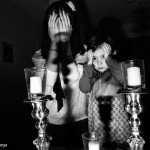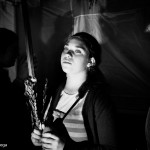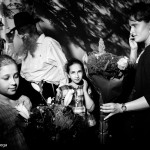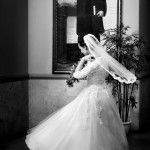Daughters of the King / Figlie di Dio
[english below]
a cura di Federica Valabrega*
“Daughters of the King” è un progetto personale che vuole esplorare il ruolo delle donne ebree ortodosse all`interno delle loro comunità tra Brooklyn, Israele, Parigi Marocco e Tunisia, i cinque maggiori focolari dell`ortodossia ebraica. “Daughters of the King” è un percorso conoscitivo tramite il quale, dopo tre anni di scatti, di incontri e di amicizie, ho potuto scovare la profonda bellezza spirituale di queste donne così “preziose e segrete” seppur all`interno di una società estremamente rigida e regolata da leggi severe sulla privacy e sul rispetto dell`immagine sacra di una donna sposata.
Le donne che ho conosciuto e che mi hanno accompagnato di questi anni di scoperte, sono donne che non mi hanno solo “prestato le loro storie,” ma mi hanno presa per mano e indicato la via per la conoscenza di me stessa attraverso, non solo la riscoperta delle mie radici ebraiche, ma la storia e le tradizioni di un popolo millenario in tutte le sue sfaccettature. La mia Nashama (anima) prima solitaria, si è posata tra le loro ed ha trovato nutrimento dal confronto ed è risbocciata diversamente come donna e come essere umano.
E` tutto cominciato quando avevo quattordici anni e seduta vicino a mia nonna in sinagoga le chiedevo spiegazioni sul perché` le donne dovessero sedere separate dagli uomini e perché ‘non fosse permesso loro di scendere sulla Teva’ (Arca Santa) e leggere la Torà ad alta voce come agli uomini.
Poi, crescendo e leggendo i racconti di Chiam Potok e Perl Abraham, ho cominciato a capire che la religione ebraica era una religione molto complessa di quanto avessi mai pensato e che il ruolo dell`uomo e della donna fossero estremamente definiti e separati, ma non perché` l`uno prescindesse l`altro e perché` dovessero essere considerati più o meno importanti all`interno della stessa comunità`, ma diversi solamente nel rispetto della vera essenza dell`anima maschile e quelle femminile e le loro relative sensibilità`.
Però mi è sempre rimasto un interrogativo sul perché le donne non fossero più partecipi nella vita religiosa e perché` dovessero` invece passare la maggior parte del loro tempo a casa a crescere i figli e a lavorare nell`ambiente domestico. Cosi`, una volta trasferitami a Brooklyn nel 2010 ho deciso che sarebbe stato il momento giusto per addentrarmi in queste comunità di religiosi vicino a casa mia e capirli più da vicino.
 Allora, prima a mo` di “estranea tra noi” e poi, piano piano, costruendo dei rapporti più duraturi e personali con queste donne, sono arrivata a fotografarle e a parlarci nella loro più profonda intimità`, fino a divenire anche io in qualche modo “più donna e più ebrea” e forse anche più spirituale e a capire davvero il motivo di tanta modestia e riflessione interiore.
Allora, prima a mo` di “estranea tra noi” e poi, piano piano, costruendo dei rapporti più duraturi e personali con queste donne, sono arrivata a fotografarle e a parlarci nella loro più profonda intimità`, fino a divenire anche io in qualche modo “più donna e più ebrea” e forse anche più spirituale e a capire davvero il motivo di tanta modestia e riflessione interiore.
Il mio progetto si basa fortemente su una frase che spiega l`essenza della donna ebrea religiosa: “Col Cvuda` Bat Melech Pnima,” che significa “L`orgoglio di una Figlia di Dio si annida nelle più segrete venature della sua anima”
Questo, in breve è il motivo perché` agli occhi di noi passanti esterni alla comunità ebraica religiosa possa sembrare che queste donne vivano un ruolo del tutto marginale e che siano inferiori ai mariti che passano gran parte della loro giornata in sinagoga, mentre loro invece vivono nel pieno della vita domestica e scolastica dei loro figli.
Il loro vivere meno sociale e il loro starsene da parte esponendosi il meno possibile al mondo esterno è un motivo di crescita spirituale interiore che non ha bisogno di stimoli esterni, ma solo di conoscenza interiore. Che se uno ci pensa bene e ci riflette non è del tutto lontano dal “conosci te stesso” di Socrate e dallo “stare in disparte” dei monaci Buddisti e dal voler meditare nel tempio della propria anima come fanno “i praticanti dello Yoga.”
La donna è la colonna portante della tradizione ebraica. Lei è la casa, la famiglia e la specchio che riflette la luce della conoscenza religiosa del marito e condivide con il mondo. Lei è il vascello della crescita interiore di tutti, ma il suo modo, la sua maniera di dichiararlo è silenziosa, modesta, personale e quasi nascosta, perché` in essa risiede la forza della sua bellezza interiore.
“Daughters of the King” è il mio modo di spiegare al mondo questa cultura così segreta e seppur così profonda. Le foto che ho scattato in questi tre anni sono attualmente esposte presso la Ermanno Tedeschi Gallery di Roma dal 24 Ottobre 2013 fino al 15 gennaio 2014 e verranno poi portate a Milano e a Torino per due ulteriori mostre sempre seguite dalla Tedeschi Gallery. L`ultima tappa della mostra sarà la citta Israeliana di Tel Aviv. Affiancherà la mostra un libro fotografico che includerà una selezione più ampia delle immagini.
Federica Valabrega*
*Federica ha recentemente vinto il Premio di giornalismo Amerigo (edizione 2013) nella categoria Fotografia
Daughters of the King
a photographic essay by Federica Valabrega
“Daughters of the King” is my long-time photography project on the women of G-d, the ones “who bare the children of the Torah,” the pillars of the Jewish traditions.
“Daughters of the King” is a journey through the voices of orthodox Jewish women from Brooklyn to Jerusalem to Paris to Morocco and Tunisia. “Daughters of the King” is an adventure that started four years ago as a photography workshop assignment and turned into a self-discovery tale to find my voice as a Jewish woman through the nashamas of these religious women.
“I do not choose the women I end up photographing. They choose me. It feels like a magnetic force attracts me to them and lets them open up to me as if they had been waiting for me all along. While it is mysteriously quite the opposite.”
Every encounter, every chat, every photo shoot, is a chance for me to challenge myself in the face of their belief and see where my soul ends and where theirs begins. This magnetism is my way inside the Torah. These women have not only lent me their stories, they have also opened my heart to my own spirituality showing me what it means to be a real “Daughters of the King” above and beyond the limits of religion.
Since I was a little girl I have always been curious why Jewish women had to pray separately from the men. Having to look down while the men read and carried the Torah around the temple often made me feel as an external presence in this spiritual experience. Why are women not ‘called up’ to the Teva` to read from the Holy scroll? Why are they to braid the Challah and why are they the ones who have to light the candles on Shabbat Eve, but they cannot be more involved in the traditions of Jewish learning? Are those differences a big enough reason to consider Orthodox Jewish women inferior to their husbands? For years I left those questions unanswered. I rebelled against my Jewish roots because I feared the answered I was going to get were never going to convince me that it was right for women to be considered different than men.
Having moved to Brooklyn in 2010, where every other person I met around is an Orthodox Jew, I felt compelled to explore the Jewish woman identity further. And what better way to do so if not by getting to know Orthodox Jewish women, share their stories of spiritual growth and photograph them? And so I did for about two years, after which though, I decided my project needed more depth than just the Jews on Brooklyn streets. It necessitated more variety.
 So I raised money via kickstarter and left for Israel soon after. I wanted to see beyond the religious Jews of the Diaspora. I wanted to go to “the source” of their spiritual growth. I spent four months in the land of “Milk and Honey” getting lost among all sorts of Orthodox Jewish communities, more than I ever imagined existed. I gathered stories, photos, and spiritual wisdom. Israel brought my photography project to a whole different level. My time in Israel made me realize, my photography story transcends to women generally, not just Jewish women. It is like a snapshot into this world that not many people outside of the community know and may have too many cliques about.
So I raised money via kickstarter and left for Israel soon after. I wanted to see beyond the religious Jews of the Diaspora. I wanted to go to “the source” of their spiritual growth. I spent four months in the land of “Milk and Honey” getting lost among all sorts of Orthodox Jewish communities, more than I ever imagined existed. I gathered stories, photos, and spiritual wisdom. Israel brought my photography project to a whole different level. My time in Israel made me realize, my photography story transcends to women generally, not just Jewish women. It is like a snapshot into this world that not many people outside of the community know and may have too many cliques about.
The project took a life on its own, and I started thinking to make more appealing to non-Jews I needed to extend the research to the Jewish communities of religious women in Europe, the more modern version of religion, the “fancier face of feminism.”
So, on my way back to New York City, I stopped in Paris to visit with the Sefardi and Mizrahi Jewish women and I felt in love with the community of Gerbian women, Tunisian Jews who came across the Mediterranean sea to France to find independence, to learn how to read and write and to become free from their “house-wives identity.”
In the summer of 2013 I travelled to Morocco and Tunisia to gathered even more material of the Sefardi Jews in the Arab Maghreb. I completed my project landing in Casablanca, Essouira and Marrakesh in Morocco and later in Djerba, a little island of Tunisia where the Jews I met in Paris actually came from.
 The idea was always the one of spending time with these women in their homes, praying with them, and getting closer to their spiritual beauty so to show, using photographs of daily chores, prayers and touchy every-day-life moments, what being a woman in the Jewish Orthodox faith actually means. The project is entirely dedicated to women and their feminine energy within strict religious contexts. Judaism, more often than not, is seen by many as a patriarchal religion. I wanted to present a whole, new chapter dedicated to the women. So women in my project became the center of attention. This was not because of their attractiveness, but because of individuality and a personal identity formed by a number of different attributes: Femininity, sensuality, holiness, religion, modesty and respect. In the book, though, there are also images of men, but they exist as accessories because the male figure is not central in this case, although his role in the Jewish faith is more often than not erroneously considered dominant.
The idea was always the one of spending time with these women in their homes, praying with them, and getting closer to their spiritual beauty so to show, using photographs of daily chores, prayers and touchy every-day-life moments, what being a woman in the Jewish Orthodox faith actually means. The project is entirely dedicated to women and their feminine energy within strict religious contexts. Judaism, more often than not, is seen by many as a patriarchal religion. I wanted to present a whole, new chapter dedicated to the women. So women in my project became the center of attention. This was not because of their attractiveness, but because of individuality and a personal identity formed by a number of different attributes: Femininity, sensuality, holiness, religion, modesty and respect. In the book, though, there are also images of men, but they exist as accessories because the male figure is not central in this case, although his role in the Jewish faith is more often than not erroneously considered dominant.
Behind my camera lens I have tried to show if there was really a need for others to judge these women as inferior to their husbands or if this belief was only mere imagination.
In these years of research, I have only noticed that these Orthodox women are not at all inferior; they are “machines” oiled to perfection. They are the “pillars of a secular tradition” of incredibly rigorous laws and regulations (inside and outside the synagogue) that today stand by only thanks to them who teach them to their children and their children’s children…They feed a family of 13 while finding time to have a full-time job and sometimes even go for a jog in the park.
According to Kabbala, the main mystical Jewish text, women do not have to pray because they have G-d built inside them more so than men. While men have to be reminded of his presence three times a day when they are called to prayer. Women sit separately from the men in the synagogue because this way they are closer to G-d and they are not disturbed in their prayers from the “wondering eyes of the males.” Also, according to Kabbala, when Moshiach will come, the world will run according to the feminine presence, the Malchus.
This project could open the eyes of many to another side of religious beauty, the side of the “Malkas of the Torah,” the “Queens of the Bible.”
















There are no comments
Add yours